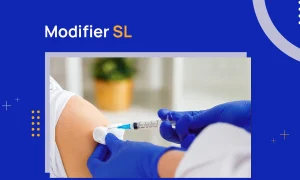Running a healthcare business is no joke. Hospitals and healthcare providers face many challenges that significantly disrupt their revenue cycle. Claim denials and payment delays are at the top of the list.
You can get an idea of the severity of the issue from the recent data. According to a report published by the American Hospital Association, nearly 15% of all claims submitted are denied initially. Plus, the losses from these denials are huge and cost the U.S. healthcare system billions of dollars every year.
Now, you can come across many different types of denial codes as a medical coder. One of the most commonly issued by insurance payers is the CO 11 denial code. But what is it, and how can you prevent it?
Well, that’s what we are going to find out in this blog. This blog will provide a detailed guide on the CO 11 denial code, its causes, prevention strategies, and steps for resolution. So, let’s start.
CO 11 Denial Code Description
Before moving on to the prevention and resolution, it is first essential to understand and go through the CO 11 denial code description.
In medical billing and coding terminology, the CO 11 denial code is sometimes called a “Diagnosis and Procedure Mismatch.” This error occurs when a claim is denied because the diagnosis code (ICD) does not support or justify the procedure code (CPT).
We know this is a little complex. Let’s try to break it down in simpler terms. When you file a claim, the insurance company might find that the diagnosis you put in the claim is inconsistent with the medical service performed. They make this decision based on a specific set of pre-determined policies. These policies are, in turn, dependent on the patient’s insurance coverage.
For example, if a claim pairs a routine diagnosis, like a common cold, with an advanced surgical procedure, the mismatch will trigger denial code CO 11.
What Causes the CO 11 Denial Code?
Let’s now discuss the most common root causes of the CO 11 denial code.
Incorrect or Outdated Codes
The biggest reason why hospitals might get CO 11 denials is ignorance and not keeping up with the latest coding guidelines.
If you are not up to date with the latest developments and changes in medical code sets, you will naturally use incorrect or outdated codes.
Errors in selecting diagnosis or procedure codes, such as using an outdated ICD or CPT code, can lead to mismatches.
Coding systems like CPT and ICD-10 are updated annually, so healthcare providers must continuously train their staff.
Lack of Medical Necessity
This is where you need to be very careful. Insurance payers often deny claims if the diagnosis fails to justify the procedure’s medical necessity. Even if the codes are correct, an insurance company may decide that the procedure is unnecessary based on the reported diagnosis.
Insufficient Specificity in Diagnosis Codes
Another similar reason why an insurance payer may trigger a CO 11 denial code is the non-specificity in your claim. Modern coding standards demand precise documentation. This means that if you use generic or vague diagnosis codes, you may face denials.
This is especially true when specific codes are required to align with advanced procedures. For example, submitting a diagnosis of “unspecified abdominal pain” (ICD-10 code R10.9) for a detailed procedure like a laparoscopic appendectomy could lead to a denial because the diagnosis lacks the specificity to justify the procedure.
Incorrect Modifier Usage
Some people think modifiers are not essential and putting vague or incorrect modifiers in the claim won’t have any effect. However, this is far from the truth.
Modifiers clarify the procedural context and justify why you have provided a service. If you miss a modifier or use the incorrect modifier, it can create inconsistencies between the diagnosis and the procedure. This will then undoubtedly result in a CO 11 denial.
Unbundling of Services
When services meant to be reported as a single bundled procedure are billed separately, it may lead to denial code CO 11. Not only do insurance companies send you a denial, but unbundling is considered a crime, and they can report you to legal bodies. To be honest, the consequences are severe, ranging from penalties to imprisonment and cancellation of license.
How to Prevent Denial Code CO 11?
We all know that prevention is better than cure. The same goes for the denial code. Below are some actionable strategies to reduce the likelihood of this denial:
Ensure Accurate and Specific Documentation
The best thing you can do as a healthcare provider is to ensure that all the claims are submitted with complete and comprehensive documentation. This will help you avoid any gaps in your case. Include detailed clinical notes, diagnostic tests, and patient history to establish medical necessity and support the procedure.
Stay Updated on Coding Guidelines
You should also train your staff on the latest ICD and CPT updates. Conduct training sessions at least twice a year. Also, if you hire new and inexperienced medical billers and coders, help them get multiple certifications.
Leverage Automated Coding Software
Technology is a must in today’s healthcare sector. If your billers and coders are still doing all the work manually, then it is almost impossible for your organization to keep up with the competition and even your own benchmarks.
Investing in automated coding tools or computer-assisted coding (CAC) systems can significantly improve coding accuracy. These tools flag potential inconsistencies before claims are submitted. So, this step is a must if you want to avoid getting denial code CO 11.
Conduct Internal Audits
Scheduling regular audits is a good practice to reduce the chance of denials. By auditing the entire process and your employees, you can find patterns of coding errors and documentation gaps. After this, you can take the necessary steps to rectify these problems.
How to Resolve Denial Code CO 11?
Now comes the interesting part. If, even after all the preventive measure,s an insurance payer triggers the denial code 11, here is how you can tackle it.
Step 1: Review the ERA/ EOB
The first step in managing the denial is to identify why an insurance provider has triggered a denial code. This can be done by thoroughly reviewing the electronic remittance advice (ERA) sent to the healthcare provider or the explanation of benefits, which is provided to the patient.
The payer’s remarks typically indicate where the diagnosis and procedure codes conflict. Focus on the 835 Healthcare Policy Identification Segment (if available) for detailed policy explanations and additional guidelines.
In this document, you will find the reason for the denial. Most probably, the reason will be from the list that we shared earlier.
Step 2: Verify Codes for Accuracy
Once you have read the denial details, double-check the diagnosis and procedure codes submitted on the claim. You have to ensure that all the codes a coder has submitted are accurate, up-to-date, and specific enough to justify the procedure.
- Diagnosis Codes: Replace vague codes with precise ICD-10 codes.
- Procedure Codes: Confirm that the CPT or HCPCS codes accurately reflect the service provided.
- Modifiers: Review and correct any missing or misapplied modifiers.
Step 3: Consult Supporting Documentation
Checking and correcting the codes and modifiers is one thing. But to completely rectify the denial code, you must gather all relevant medical records, including clinical notes, diagnostic tests, and imaging reports.
The purpose of this exercise is to gather and provide evidence to establish the relationship between the diagnosis and procedure.
Step 4: Collaborate with Providers
Once you have identified your mistake and gathered the correct codes and all the documents, the next step is to discuss the denial and all these details with the physician or clinical team responsible for the claim.
Explain all the discrepancies to them. If they provide new information, include it in your case. This will strengthen your resubmission request.
Step 5: Submit a Corrected Claim or Appeal
Once everything is organized and ready, make necessary adjustments to the codes or documentation and resubmit the claim.
If you believe the denial was unwarranted, prepare a strong appeal. Include additional documentation and a detailed explanation supporting the procedure’s medical necessity.
Step 6: Monitor and Follow Up
That’s it. That’s the complete process of managing a CO 11 denial code. All you have to do now is track the claim’s progress after resubmission.
For this, follow up with the payer consistently until your problem is solved. When we say follow-up, we don’t mean to get on the nerves of the insurance company. Make a schedule to follow up every week or after every 15 days.
Final Thoughts on CO 11 Denials
Denial codes, especially the CO 11 denial code, can significantly affect your revenue cycle. The best way to prevent and solve such denials is to adopt a systematic approach. This includes proper documentation standards, implementing computer-based coding systems, etc.
If you have already applied these suggestions and CO 11 denials are still overwhelming your practice, our denial management services can help. NeuraBill’s certified billers and coders have decades of experience handling all types of denial codes. Contact us today to be free from all coding issues.



